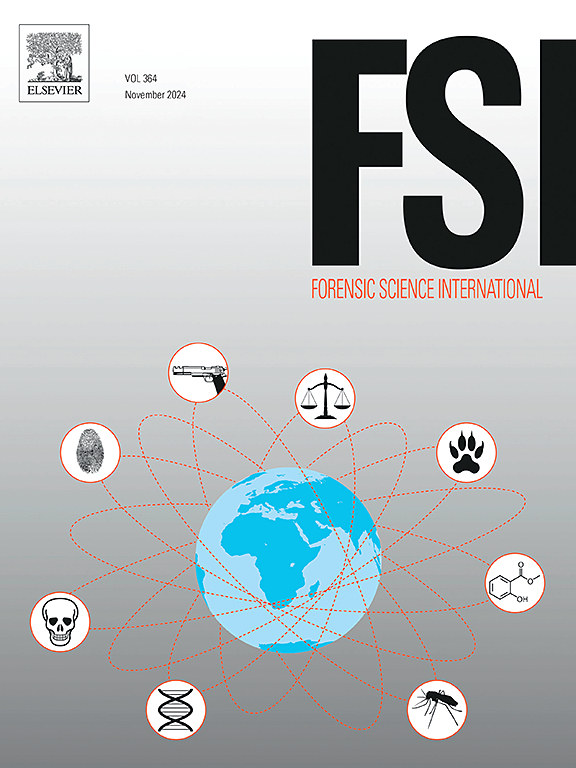Taphonomy and diagenesis of submerged bone: An experimental approach
IF 2.5
3区 医学
Q1 MEDICINE, LEGAL
引用次数: 0
Abstract
Bone taphonomy and diagenesis contribute to anthropological analysis in forensic investigations by attempting to reconstruct the relationship between human cadaveric remains and their postmortem depositional environment. The rare aquatic taphonomic experiments have been delivering conflicting results on the influence of time and the environment on the decay of bone and teeth, especially considering that the main diagenetic processes can lead to fragmentation, progressive dissolution or fossilization. The aim of this experimental, quantitative, randomized and controlled 2-year study was to analyse the taphonomy and diagenesis of submerged terrestrial mammalian bones to achieve a more accurate estimation of both the post-mortem interval (PMI) and the post-mortem submersion interval (PMSI) in the short term. Three parameters of bone diagenesis, the Oxford Histological Index (OHI), the total porosity and the collagen content of cortical bone were analysed by MicroCT Scan, bright-field Light Microscopy (Picrosirius Red stain), Scanning Electron Microscopy (SEM) and Laser ablation inductively coupled plasma mass spectrometry (LA-ICP-MS) on 75 sheep femurs and tibias placed in four distinct types of environment (natural saltwater, natural freshwater, an artificial seawater solution and exposed to the air) vs. non-exposed controls. LA-ICP-MS was soon discontinued because no measurable changes of the elemental profiles could be detected. Multivariate statistical analysis was applied to the collected data. The macroscopical preservation was consistently excellent (OHI=5). The total porosity and the degradation of collagen were greater underwater than in subaerial exposure, whereas demineralization zones and bioerosion tunnelling appeared after 12 months in the air-exposed samples only. Underwater, the continuous movement, the correlated abrasion by sand and sediment and the constant alkaline pH (≥ 8) can explain the progressive removal of the mineral component and the subsequent exposure of collagen to bioeroders and chemical hydrolysis. On land, the same process occurs at a slower rate on account of the seasonality of the water flow, however, the action of the more abundant and diversified species of bioeroding microorganisms appears more efficient. Despite some limitations, this study indicates that three parameters of bone diagenesis can predict the depositional environment of terrestrial mammalian bone characterized by a PMI and/or PMSI of at least 12 months.
浸没骨的埋藏和成岩作用:实验方法
骨埋藏学和成岩作用通过试图重建人类尸体与其死后沉积环境之间的关系,为法医调查中的人类学分析做出了贡献。罕见的水生埋藏学实验在时间和环境对骨骼和牙齿腐烂的影响方面得出了相互矛盾的结果,特别是考虑到主要成岩过程可能导致碎裂、渐进溶解或石化。这项为期2年的实验、定量、随机和对照研究的目的是分析水下陆生哺乳动物骨骼的埋藏和成岩作用,以在短期内更准确地估计死后时间间隔(PMI)和死后淹没时间间隔(PMSI)。采用MicroCT扫描、亮场光学显微镜(Picrosirius Red染色)、扫描电镜(SEM)和激光烧蚀电感耦合等离子体质谱(LA-ICP-MS)对75只羊股骨和胫骨分别置于4种不同的环境(天然盐水、天然淡水、天然水和天然水)中,分析了骨成岩作用的3个参数、牛津组织学指数(OHI)、皮质骨总孔隙度和胶原蛋白含量。人工海水溶液(暴露在空气中)vs.非暴露对照组。由于无法检测到元素谱的可测量变化,LA-ICP-MS很快就停止了。对收集的资料进行多元统计分析。宏观保存效果一贯良好(OHI=5)。总孔隙度和胶原蛋白的降解在水下比在地面暴露时更大,而脱矿带和生物侵蚀隧道在12个月后才出现在空气暴露的样品中。在水下,持续的运动、沙子和沉积物的相关磨损以及恒定的碱性pH值(≥8)可以解释矿物成分的逐渐去除以及胶原蛋白随后暴露于生物侵蚀剂和化学水解。在陆地上,由于水流的季节性,同样的过程以较慢的速度发生,然而,生物侵蚀微生物种类更丰富和多样化的作用似乎更有效。尽管存在一些局限性,但本研究表明,骨成岩作用的三个参数可以预测陆生哺乳动物骨骼的沉积环境,其特征为至少12个月的PMI和/或PMSI。
本文章由计算机程序翻译,如有差异,请以英文原文为准。
求助全文
约1分钟内获得全文
求助全文
来源期刊

Forensic science international
医学-医学:法
CiteScore
5.00
自引率
9.10%
发文量
285
审稿时长
49 days
期刊介绍:
Forensic Science International is the flagship journal in the prestigious Forensic Science International family, publishing the most innovative, cutting-edge, and influential contributions across the forensic sciences. Fields include: forensic pathology and histochemistry, chemistry, biochemistry and toxicology, biology, serology, odontology, psychiatry, anthropology, digital forensics, the physical sciences, firearms, and document examination, as well as investigations of value to public health in its broadest sense, and the important marginal area where science and medicine interact with the law.
The journal publishes:
Case Reports
Commentaries
Letters to the Editor
Original Research Papers (Regular Papers)
Rapid Communications
Review Articles
Technical Notes.
 求助内容:
求助内容: 应助结果提醒方式:
应助结果提醒方式:


